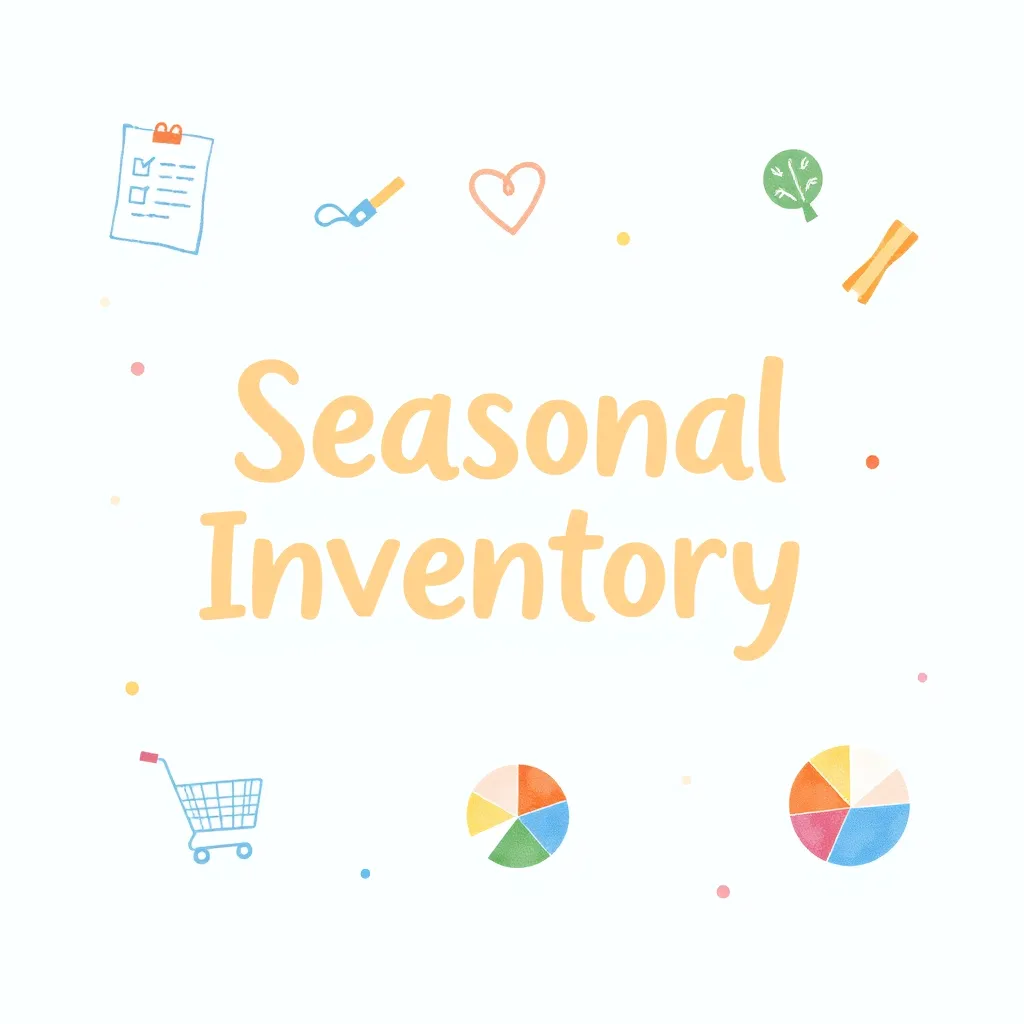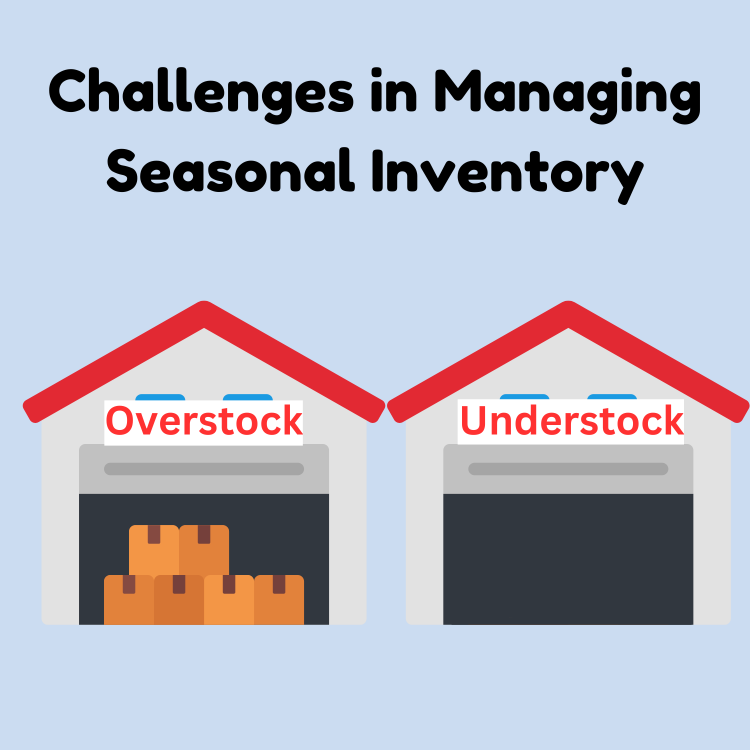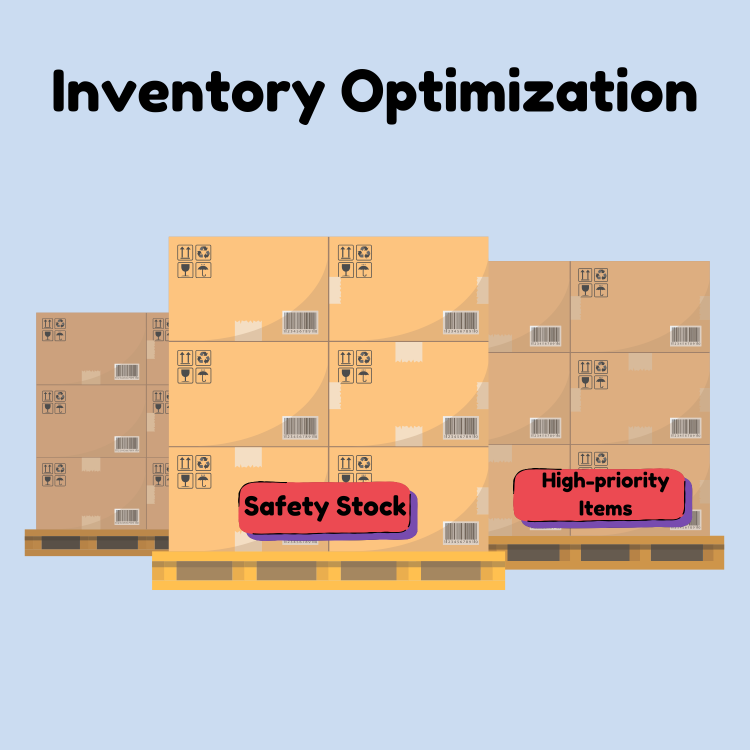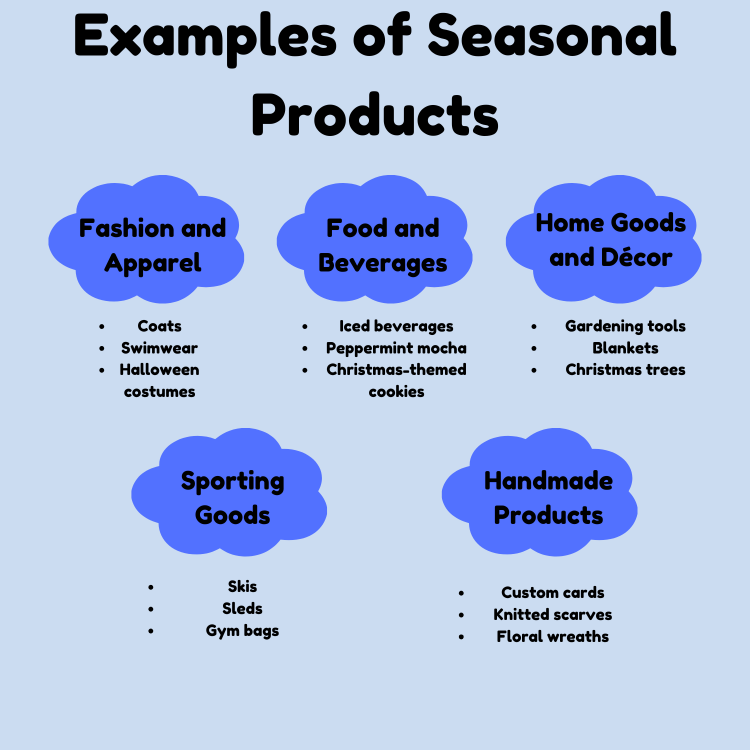Seasonal Inventory: Effective Management, Demand Strategies, and Product Examples [2024]
A practical guide to managing seasonal inventory, balancing demand, and improving efficiency throughout the year.

Managing seasonal inventory is a balancing act that every business must navigate. With fluctuating demand, limited selling windows, and the risks of overstocking or stockouts, it’s crucial to have a clear plan in place. This guide explores practical strategies and tools to help businesses prepare for seasonal peaks, streamline operations, and make informed decisions, ensuring both profitability and customer satisfaction throughout the year.
Table of Contents
- Understanding Seasonal Inventory
- Effective Seasonal Inventory Management
- Seasonal Demand Strategies
- Examples of Seasonal Products
- Best Practices for Seasonal Inventory
- Frequently Asked Questions (FAQs)
- Summary
Understanding Seasonal Inventory
What is Seasonal Inventory?

Seasonal inventory refers to stock that businesses maintain to meet demand fluctuations during specific times of the year. These products experience heightened sales due to seasonal trends, holidays, or weather changes. For example:
- Winter: Holiday decorations, snow boots, and skiing equipment.
- Summer: Swimwear, sunscreen, and barbecue grills.
- Holidays: Valentine’s chocolates, Easter eggs, or Halloween costumes.
Seasonal inventory ensures businesses can capitalize on peak periods by offering relevant products at the right time. However, managing it effectively requires precise forecasting and inventory planning to avoid overstocking or missing out on demand.
Challenges in Managing Seasonal Inventory
While seasonal inventory can boost revenue, it also presents unique challenges:
- Demand Unpredictability: Sudden changes in trends or customer behavior can lead to either shortages or excess stock. For more information on stockouts, read our article here.
- Risk of Overstocking: Unused seasonal inventory at the end of a period ties up capital and occupies valuable storage space.
- Supplier Coordination: High demand during peak seasons can strain supplier capabilities, leading to delays.
- Short Selling Windows: Seasonal products often have a limited timeframe for sales, increasing the urgency to meet demand precisely.
Businesses need robust strategies to balance supply and demand, ensuring profitability without unnecessary waste. Modern tools like OneCart can streamline inventory tracking and prevent stockouts during critical times, making seasonal inventory management more efficient.

Effective Seasonal Inventory Management
Managing seasonal inventory requires a proactive approach to ensure businesses can meet customer demand while avoiding unnecessary costs. Below are key strategies to achieve success:
1. Demand Forecasting

Accurately predicting customer demand is critical to maintaining the right inventory levels. This involves analyzing:
- Historical Data: Use past sales trends to estimate demand for upcoming seasons.
- Market Trends: Monitor consumer behavior and emerging trends that may impact demand.
- External Factors: Account for factors like economic shifts or competitor actions.
Example: A clothing retailer analyzes the previous three years’ winter sales to determine stock levels for coats and boots. Using tools like OneCart’s analytics, businesses can easily identify patterns and refine their forecasts.
2. Inventory Optimization

Optimizing inventory ensures a balance between sufficient stock and minimal waste.
- Implement Safety Stock: Maintain a buffer to handle unexpected demand spikes.
- Automate Reorder Points: Use technology to trigger restocking when inventory levels drop below a set threshold.
- Categorize Stock by Priority: Identify fast-moving seasonal products and prioritize their replenishment.
Example: A retailer uses OneCart to set automated reorder points for high-demand items like holiday decorations during December.
3. Supplier Coordination

Collaborating closely with suppliers is vital for timely replenishment during seasonal peaks.
- Pre-order Stock: Secure inventory well before peak periods to avoid shortages.
- Establish Backup Suppliers: Mitigate risk by diversifying supplier sources.
- Negotiate Flexible Terms: Arrange for expedited shipping during high-demand periods if necessary.
Example: A toy store pre-orders popular holiday items in September and maintains a secondary supplier to address last-minute surges.
Tools and Technologies
Modern tools make seasonal inventory management more efficient and accurate. Key technologies include:
- Inventory Management Software: Platforms like OneCart offer centralized control over inventory, ensuring real-time visibility and automation.
- Predictive Analytics: Use AI-driven tools to analyze historical data and predict demand fluctuations.
- ERP Integration: Streamline inventory, sales, and supplier data for seamless operations.
Seasonal Demand Strategies
Managing seasonal demand requires a combination of strategic pricing, marketing, and inventory adjustments. These strategies help businesses optimize sales and maintain customer satisfaction during peak periods.
1. Price Segmentation
Adapting pricing strategies based on seasonal trends can maximize revenue and attract different customer segments.
- Peak Pricing: Increase prices slightly during high-demand periods to reflect scarcity or premium value.
- Discounted Off-Season Pricing: Offer reduced prices after the season to clear out inventory.
- Segment-Specific Pricing: Adjust prices for different customer groups based on purchasing behavior.
Example: A retailer increases prices on holiday-themed products during December and offers clearance discounts in January.
2. Promotional Campaigns
Targeted marketing efforts can drive sales and capture attention during competitive seasonal periods.
- Limited-Time Offers: Create urgency with flash sales or time-sensitive discounts.
- Seasonal Bundles: Combine complementary products into discounted bundles (e.g., sunscreen and beach towels for summer).
- Loyalty Rewards: Offer exclusive discounts to repeat customers or members of loyalty programs.
Example: A business launches a “12 Days of Christmas” sale with daily deals to boost holiday sales and clear inventory.
3. Product Bundling
Bundling products is an effective way to increase average order value while appealing to customer convenience.
- Complementary Bundles: Pair items that are often purchased together, like winter hats and gloves.
- Seasonal Bundles: Group products designed for specific events, such as picnic supplies for summer or back-to-school essentials in autumn.
Example: A sporting goods store offers a winter sports bundle with a snowboard, boots, and gloves at a discounted rate.
Preparing for the Off-Season
Seasonal demand doesn’t end with the season. Preparing for the quieter months ensures inventory and cash flow remain optimized. Businesses can take proactive steps to maximize their resources and remain financially stable until the next peak period.
1. Diversify Offerings
Expanding product lines to include non-seasonal items or services can help stabilize income during the off-season. By introducing versatile products that customers need year-round, businesses can avoid lulls in sales and reduce reliance on seasonal peaks.
- Example: A business specializing in holiday lights can expand into general home lighting solutions, such as energy-efficient LED bulbs or smart lighting systems, to appeal to customers regardless of the season. This approach not only generates consistent revenue but also builds a broader customer base.
2. Liquidation Strategies
Clearing out seasonal inventory is essential to free up storage space, recover costs, and improve cash flow for upcoming operations. Effective liquidation methods include:
- End-of-Season Sales: Offer deep discounts to move unsold products.
- Partnerships with Discount Retailers: Sell excess stock to third-party discount stores.
- Donations for Tax Benefits: Donate unsold inventory to charities to gain goodwill and possible tax deductions.
Example: A clothing retailer partners with an outlet store to sell unsold winter coats in the spring, while also donating a portion to local shelters to create positive brand recognition.
Examples of Seasonal Products

Certain product categories are particularly suited for seasonal demand. Below are examples of industries and their key seasonal products:
1. Fashion and Apparel
Seasonal changes greatly influence fashion trends, with specific clothing lines designed for weather and holidays.
- Winter: Coats, scarves, and thermal wear.
- Summer: Swimwear, hats, and flip-flops.
- Holidays: Festive outfits for Christmas, Halloween costumes.
Example: A retailer launches a fall collection featuring sweaters and boots in September to align with cooler weather.
2. Food and Beverages
The food and beverage industry thrives on seasonal offerings that cater to customer preferences during specific times.
- Summer: Iced beverages, barbecue sauces, and picnic snacks.
- Holidays: Pumpkin spice products in fall, chocolate Easter eggs, Christmas-themed cookies.
- Seasonal Harvests: Products tied to seasonal produce, such as strawberry preserves in spring.
Example: A coffee chain introduces a peppermint mocha exclusively during the holiday season.
3. Home Goods and Décor
Demand for home-related products spikes during seasonal events or holidays.
- Spring: Gardening tools, outdoor furniture, cleaning supplies.
- Winter: Holiday decorations, heating appliances, blankets.
- Holidays: Festive items like Christmas trees, wreaths, or candles.
Example: A home goods store markets LED Christmas lights starting in early November.
4. Sporting Goods
Sports and outdoor equipment vary by season and weather.
- Winter: Skis, snowboards, and sleds.
- Summer: Camping gear, beach equipment, and hiking boots.
- Back-to-School Season: Gym bags, sportswear, and backpacks.
Example: A sporting goods retailer offers discounts on summer hiking gear in late spring to attract early buyers.
5. Artisanal and Handmade Products
Crafts and handmade items often align with holidays or special occasions.
- Holidays: Personalized ornaments, custom cards, or handmade candles.
- Seasonal Themes: Floral wreaths for spring or fall, knitted scarves for winter.
Example: An Etsy seller promotes hand-knit stockings during November and December.
Best Practices for Seasonal Inventory
To manage seasonal inventory effectively, businesses must adopt best practices that align with their operational goals and customer expectations. These strategies ensure inventory levels are optimized, costs are controlled, and customer satisfaction is maximized.
Do: Analyze Past Performance
- Use historical sales data to forecast demand for the upcoming season.
- Identify trends, such as best-selling items or peak sales periods.
Example: A retailer analyzes the last three years of holiday sales to predict demand for Christmas lights.
Don’t: Overestimate Demand
- Avoid ordering excessive inventory that might not sell, leading to high storage costs.
- Instead, rely on demand forecasting tools to calculate realistic inventory needs.
Example: A clothing brand avoids overstocking winter jackets by tracking pre-season customer interest.
Do: Use Technology for Real-Time Insights
- Implement inventory management tools like OneCart to monitor stock levels across multiple channels.
- Automate reorder points to avoid manual errors and ensure timely replenishment.
Example: A business selling summer patio furniture uses OneCart to set automatic restocking triggers for high-demand items.
Don’t: Ignore Supplier Coordination
- Failing to communicate effectively with suppliers can result in delayed shipments or stockouts.
- Develop strong relationships and negotiate flexible terms to prepare for demand surges.
Example: A toy retailer pre-arranges expedited shipping options with suppliers for the holiday rush.
Do: Clear Excess Inventory Quickly
- Use end-of-season sales, bundles, or liquidation strategies to free up storage space and recover costs.
- Offer discounts or promotions to attract bargain hunters.
Example: A home goods store hosts a “Spring Clearance Sale” to sell remaining gardening tools.
Frequently Asked Questions (FAQs)
1. What are seasonal products?
Seasonal products are items that experience peak demand during specific times of the year, such as holidays, weather changes, or cultural events. Examples include Christmas decorations, summer swimwear, or winter tires.
2. How can businesses avoid overstocking seasonal items?
- Use historical sales data and predictive analytics to forecast demand accurately.
- Maintain safety stock to handle unexpected demand spikes while avoiding excessive inventory.
- Leverage tools like OneCart for real-time inventory management.
3. What tools are best for managing seasonal inventory?
Inventory management tools like OneCart provide centralized tracking, automate reorder points, and integrate with multichannel platforms to optimize seasonal inventory. Click here to learn more about multichannel selling.
4. How does demand forecasting help with seasonal inventory?
Demand forecasting uses historical sales data, trends, and predictive models to estimate future demand. This ensures businesses stock the right amount of inventory, preventing stockouts or overstocking.
5. What are the benefits of clearing excess seasonal inventory quickly?
- Frees up storage space for new products.
- Recovers costs through promotions or discounts.
- Enhances cash flow and reduces waste.
6. How can businesses prepare for seasonal demand fluctuations?
- Coordinate with reliable suppliers for timely replenishment.
- Implement promotional campaigns and adjust pricing strategies for high and low seasons.
- Use real-time analytics to monitor inventory levels and sales trends.
7. What role does technology play in seasonal inventory management?
Technology like inventory management software, predictive analytics, and ERP integrations streamline operations, reduce manual errors, and provide actionable insights for effective seasonal inventory control.
8. How can seasonal products benefit a business?
Seasonal products can drive significant revenue during peak periods, attract new customers, and strengthen brand loyalty. They also create opportunities for targeted marketing campaigns and cross-selling.
Summary
Seasonal inventory management is a crucial element for businesses that experience fluctuating demand throughout the year. Understanding the challenges, such as demand unpredictability and short selling windows, helps businesses make informed decisions to navigate these complexities effectively.
By leveraging demand forecasting, optimizing inventory, and integrating advanced tools like OneCart, businesses can ensure they are well-prepared for peak seasons while avoiding overstocking and operational inefficiencies during off-seasons. The right strategies not only maximize profitability during high-demand periods but also maintain customer satisfaction and operational efficiency year-round.
Ready to transform your seasonal inventory management? Start your 14-day free trial with OneCart today and experience seamless operations, real-time analytics, and centralized inventory tracking tailored to your business needs!